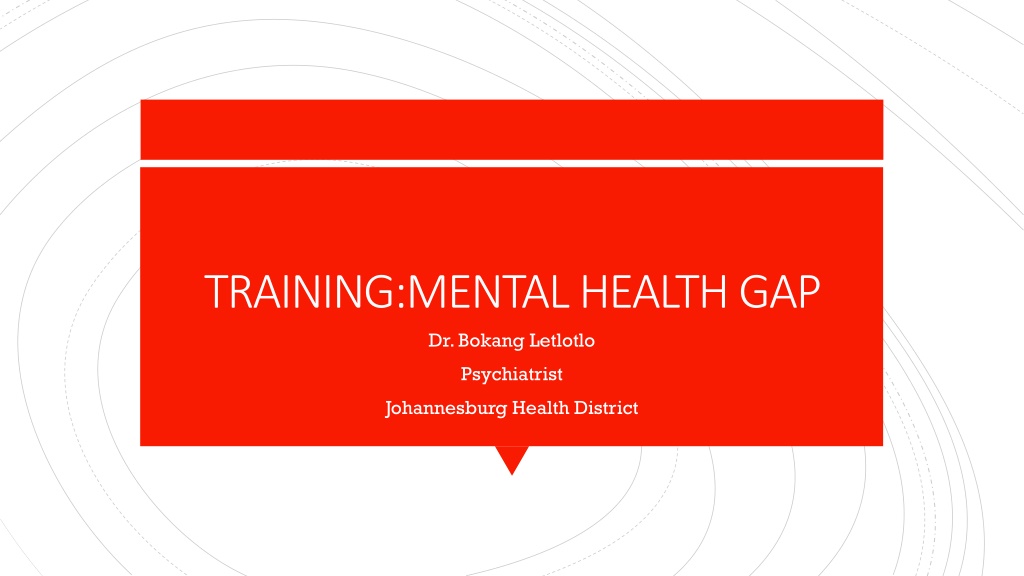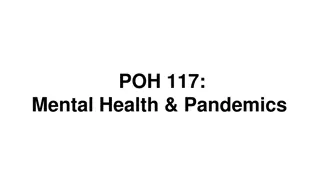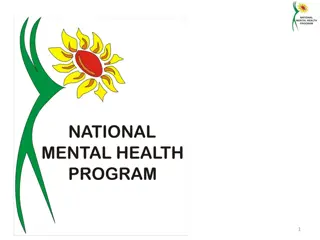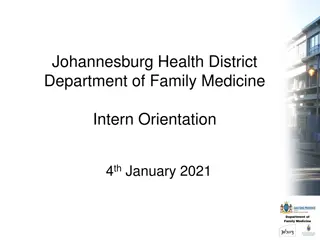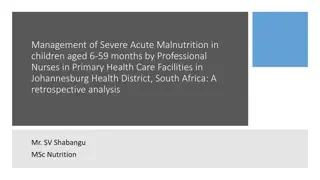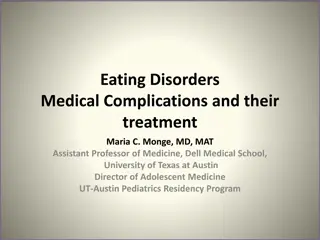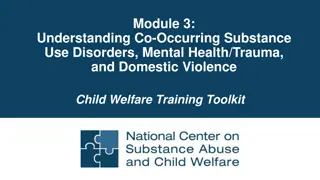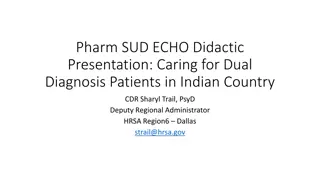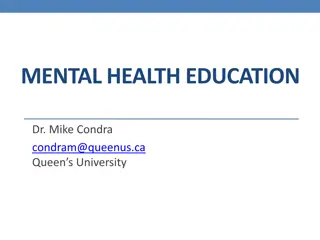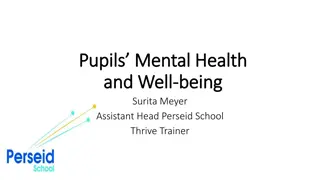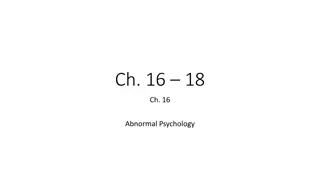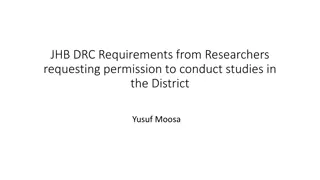Understanding Mental Health Gap and Disorders in Johannesburg Health District
Mental, neurological, and substance use disorders pose a significant burden on global health, with substantial socio-economic impacts. The WHO's Gap Action Program focuses on screening, early detection, and management of mild to moderate mental illnesses in non-specialized healthcare settings. The Stress And Health Survey in South Africa reveals high prevalence rates of anxiety, depressive disorders, and substance use disorders. Recognizing symptoms of major depressive disorder and understanding different distress patterns is crucial for early diagnosis and intervention.
Download Presentation

Please find below an Image/Link to download the presentation.
The content on the website is provided AS IS for your information and personal use only. It may not be sold, licensed, or shared on other websites without obtaining consent from the author. Download presentation by click this link. If you encounter any issues during the download, it is possible that the publisher has removed the file from their server.
E N D
Presentation Transcript
TRAINING:MENTAL HEALTH GAP Dr. Bokang Letlotlo Psychiatrist Johannesburg Health District
Mental, neurological, and substance use disorders are major contributors (14%) to global health disease burden (morbidity and mortality) WHO Also the highest stimatised illnesses/disorders Leading causes of disability globally -> significant socio-economic impact Background Low to middle-income countries Gap Action Program (GAP) developed by WHO MHGap
MHGap For use in non-specialized healthcare settings Level 1 and 2 healthcare facilities Family physicians, general practitioners (nurses and doctors), etc.. Screening, early detection, and management of mild to moderate mental illnesses Continuous monitoring and management of outpatient chronic mental illnesses Prevention of negative outcomes -> early referral!
Stress And Health Survey (SASH) study: Anxiety disorders - 8% South Africa: 16-% prevalence of mental disorders/illnesses Substance use disorders 6% Depressive disorders 5% Others: psychotic disorders, etc..
? ??: Irritable, depressed mood or anhedonia X 2 weeks Sad, irritable, teary Impaired sleep, appetite, weight, energy, libido Impaired concentration, memory Hopelessness, guilt, worthlessness Self-image problems Preoccupation with death Lack of motivation DSM 5 Criterion Diagnosing a major depressive disorder Drop in level of functioning or significant distress No previous mania, hypomania episodes No other possible medical disorders Somatic symptoms!
ANXIOUS DISTRESS -worry, tension, restless - ??????? ????? PERIPARTUM ONSET -3rd trimester- >4/52 post- partum -likely to recur ATYPICAL Fx. -mood reactivity - ?,?, S, leaden paralysis MDD specifiers PSYCHOTIC Fx. -mood- congruency **poor outcomes CATATONIC Fx. -psychomotor slowing, mutism, posturing, etc.. RAPID CYCLING -adherence, substance use, bipolar?
Empathic attitude Discuss uncertainty with a specialist at any point in the care pathway STG&EML for SA (2019) chaper 15 Assess severity of the condition and suicide risk. See PHC STGs and EML, 2018 section 16.7: Suicide risk assessment GENERAL MEASURES Exclude and optimise treatment of underlying and/or comorbid medical conditions (e.g. hypothyroidism, anaemia, HIV/AIDS, TB, cancers, diabetes) Screen for and manage underlying or comorbid substance use, e.g. nicotine, alcohol, over the counter analgesics, benzodiazepines Social worker referral in abuse cases
Mild depressive disorders: First line - PSYCHOTHERAPY Self-help options including NGOs Psychoeducation: diet, exercise, sleep, substance misuse, mobilization of support structures, etc.. Moderate severe depressive disorders: First line - Pharmacotherapy Augment with psychotherapy/self-help options Rx. Duration: Approach to management 6-12 months after first depressive episode 1-2 years after at least two episode
Citalopram: initiate at 10 mg daily 1/52 -> 20 mg daily If partial response: increase to 30-60 mg daily (except in cardiac disease and >65 years) and/or augment with psychotherapy If no response: consult with specialist (re-evaluate diagnosis, repeat general measures, adherence, substance use) Poor response: consider a switch -> fluoxetine at 20 mg for 2 4 weeks Thereafter, increase to 40-60mg mg daily. Delay dosage increase if agitation/panicky feelings occur SSRIs Reassess response after 4 6 weeks If no response: consult with specialist If a sedating antidepressant is required: Amitriptyline, oral, at bedtime Initial dose: 25 mg per day. Increase by 25 mg per day at 3 5 day intervals Maximum dose: 150 mg per day
Dos: Exercise Meal Calming techniques: 5 senses Bed used for sleeping (and intimacy) only Regular sleep cycle Sleep hygiene AVOID excessive mental stimulation: Phones, TV, social media, etc. noise LIMIT: Caffeine, alcohol, etc.. before bed
SSRIs are associated with improved symptoms in the mother and better emotional and psychological development of the child. Benefit is greater with increasing illness severity. Effect of SSRIs in pregnancy on anxiety is less clear Index presentations: offer counselling, psychotherapy; discuss risk/benefit of SSRIs Lack of matched case-control studies mean harms of treatment are unclear. If stable on an SSRI, do not stop discuss risk/benefit with mother Managing Depression in pregnancy Avoid fluoxetine due to long half-life and relatively high concentration in breastmilk. Consider citalopram All antidepressants: possible increased risk of miscarriage, transient neonatal symptoms (jitteriness, irritability), and persistent pulmonary hypertension of the newborn Avoid benzodiazepines some association with neurodevelopmental delay in the child; neonatal sedation if used late in pregnancy
SSRIs (e.g. fluoxetine, citalopram) may cause agitation and an increased suicide risk during the first 2 4 weeks. Monitor closely for clinical worsening, suicidality, or unusual changes in behavior -> advise families and caregivers TCAs can be fatal in overdose. Avoid TCAs in the elderly and patients with heart disease, urinary retention, glaucoma, and epilepsy CAUTION!! Avoid antidepressants in patients with bipolar disorder without consultation, as they may precipitate a manic episode Be aware of interactions between antidepressants and other agents (e.g. other medicines, St John s Wort or traditional African medicine)
TYPE 1 ???: Abnormally elevated, expansive, or irritable mood + energy or goal-directed activity >1/52 Inflated self-esteem, talkative, flight of ideas Risky behaviors Decreased need for sleep, ?, distractibility +?- psychosis Bipolar and related disorders TYPE 2 MDD criterion met plus Hypomanic episode: ???: same criterion as BDI Differences: Sx. present for at least 4 days Unequivocal change in functioning (uncharacteristic) No significant decline in functioning
Urgent psychiatric referral Acute containment measures: Oral/IMI sodium valproate loading 1-2g stat BNZ: eg: Lorazepam or Clonazepam 1-2mg IMI stat (1- 4mg) every 2-4 hours Haloperidol 5mg IMI (known patients) + Phernagan 25- 50mg IMI stat OR olanzapine 10mg IMI stat Bipolar and related disorders
1. Inadequate response to treatment 2. Switch to mania or hypomania or history of bipolar 3. Psychosis Refer if: 4. High suicide risk 5. Pregnancy
GRIEF OR BEREAVEMENT Intense sadness, rumination about loss Feelings of emptiness and loss -> occurs in waves. Gradually resolves Preoccupation with memories of the object lost: associated with pain, comfort, or some happiness Impairment in NVF Important differential diagnoses ADJUSTMENT DISORDER Identifiable stressor Emotional or behavioral symptoms 3/12 after the occurrence of the stressor Once stressor or its consequences have terminated, symptoms do not persist 6/12
A 30 year old female presents to the clinic after a suicide attempt by means of an overdose of 30 paracetamol tablets. She is medically stabilized and referred to you for assessment. 1. What information, about the circumstances of the attempt, would help you to decide if the patient was genuinely suicidal? The patient gives a history of feeling sad for the last 3 weeks, she is struggling to sleep at night, has very low appetite and energy and is unable to concentrate at college. She says that these symptoms started after she found out that she is pregnant. case discussion 2. How is your approach to management of the patient ? You choose to treat her with citalopram. 3. What dose would you commence with and what information will you give her regarding the use of her antidepressant?
